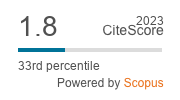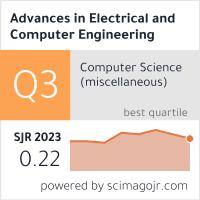| 2/2018 - 3 |
A Computationally Efficient Pipelined Architecture for 1D/2D Lifting Based Forward and Inverse Discrete Wavelet Transform for CDF 5/3 FilterCEKLI, S. |
| Extra paper information in |
| Click to see author's profile in |
| Download PDF |
Author keywords
digital systems, discrete wavelet transforms, multiprocessing systems, pipeline processing, programmable logic arrays
References keywords
wavelet(33), transform(20), lifting(16), architecture(14), discrete(13), systems(12), circuits(10), signal(9), processing(9), image(9)
Blue keywords are present in both the references section and the paper title.
About this article
Date of Publication: 2018-05-31
Volume 18, Issue 2, Year 2018, On page(s): 17 - 26
ISSN: 1582-7445, e-ISSN: 1844-7600
Digital Object Identifier: 10.4316/AECE.2018.02003
Web of Science Accession Number: 000434245000003
SCOPUS ID: 85047844169
Abstract
In this study, a simple lifting based pipeline DWT (Discrete Wavelet Transform) architecture is proposed for the operation of the CDF 5/3 (Cohen-Daubechies-Feauveau 5/3) filter. This scalable architecture is faster and capable of fulfilling the transformation utilizing the parallel processing operation units. The symmetric boundary extension method is used at the signal boundaries to obtain the best result in the case of 1D/2D. The proposed architecture utilizes the hardware resources in a quite efficient way by means of the pipeline technique. The architectural design is constituted by using RTL (Register Transfer Level) design process and coded by the Verilog HDL. The proposed architecture is tested for several 1D/2D inputs to examine its operation. The related architecture is synthesized for the FPGA board to check the results. The reverse operation is fulfilled by using the same structure only by changing the shift amounts of the shifting units. The DWT coefficients are calculated on this architecture for the 1D/2D situation. The hardware resources are used effectively by utilizing the constituted architecture in folded structure in the 2D case. Satisfying results have been obtained when the different numbers of parallel processing units are utilized. |
| References | | | Cited By |
Web of Science® Times Cited: 1 [View]
View record in Web of Science® [View]
View Related Records® [View]
Updated today
SCOPUS® Times Cited: 1
View record in SCOPUS® [Free preview]
View citations in SCOPUS® [Free preview]
[1] Statistical analysis of induced magnetic fields on oil-impregnated insulation pressboards, Atalar, Fatih, Uzunoğlu, Cengiz Polat, Cekli, Serap, Uğur, Mukden, Electrical Engineering, ISSN 0948-7921, Issue 4, Volume 102, 2020.
Digital Object Identifier: 10.1007/s00202-020-01012-8 [CrossRef]
Disclaimer: All information displayed above was retrieved by using remote connections to respective databases. For the best user experience, we update all data by using background processes, and use caches in order to reduce the load on the servers we retrieve the information from. As we have no control on the availability of the database servers and sometimes the Internet connectivity may be affected, we do not guarantee the information is correct or complete. For the most accurate data, please always consult the database sites directly. Some external links require authentication or an institutional subscription.
Web of Science® is a registered trademark of Clarivate Analytics, Scopus® is a registered trademark of Elsevier B.V., other product names, company names, brand names, trademarks and logos are the property of their respective owners.
Faculty of Electrical Engineering and Computer Science
Stefan cel Mare University of Suceava, Romania
All rights reserved: Advances in Electrical and Computer Engineering is a registered trademark of the Stefan cel Mare University of Suceava. No part of this publication may be reproduced, stored in a retrieval system, photocopied, recorded or archived, without the written permission from the Editor. When authors submit their papers for publication, they agree that the copyright for their article be transferred to the Faculty of Electrical Engineering and Computer Science, Stefan cel Mare University of Suceava, Romania, if and only if the articles are accepted for publication. The copyright covers the exclusive rights to reproduce and distribute the article, including reprints and translations.
Permission for other use: The copyright owner's consent does not extend to copying for general distribution, for promotion, for creating new works, or for resale. Specific written permission must be obtained from the Editor for such copying. Direct linking to files hosted on this website is strictly prohibited.
Disclaimer: Whilst every effort is made by the publishers and editorial board to see that no inaccurate or misleading data, opinions or statements appear in this journal, they wish to make it clear that all information and opinions formulated in the articles, as well as linguistic accuracy, are the sole responsibility of the author.





